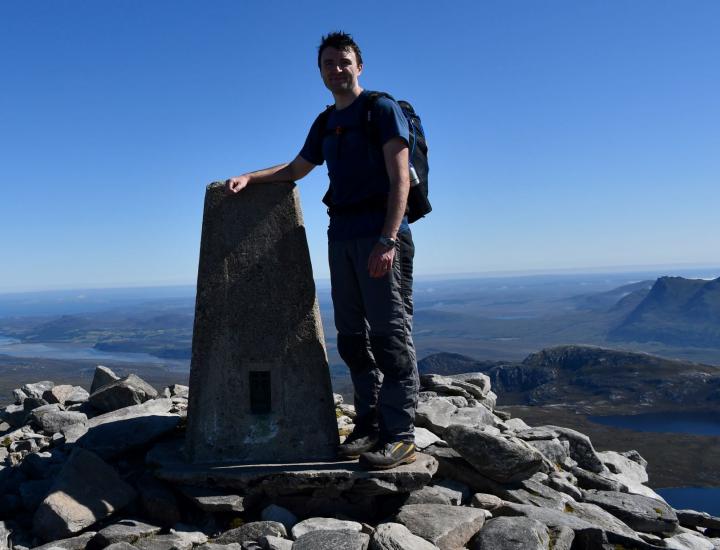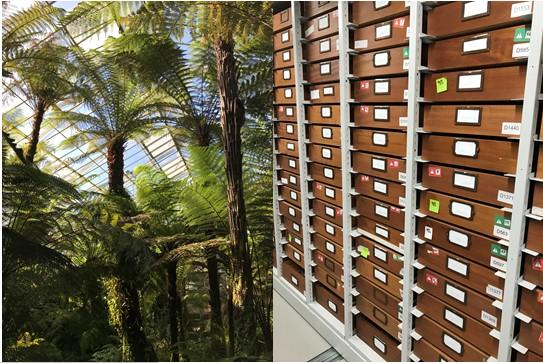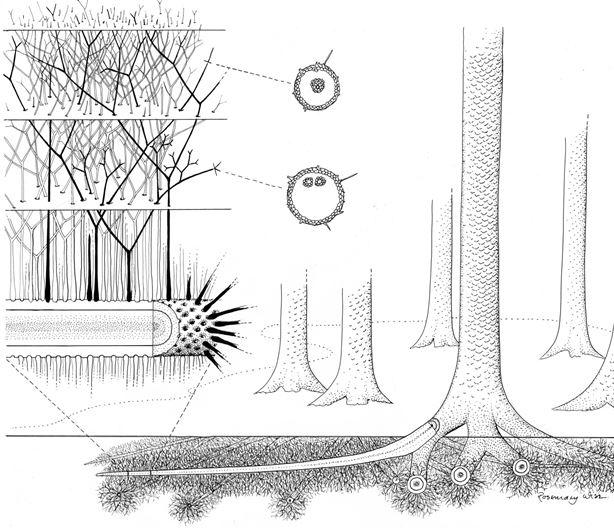Blog - A Spotlight On Dr Sandy Hetherington
Helen Foerd (final year PhD student) sat down with our new Institute of Molecular Plant Sciences member, Dr Sandy Hetherington to discuss the mysterious world of fossilised plants and scientific life.

Can you start by telling me what your background is and why you ended up here, at the Institute of Molecular Plant Sciences in Edinburgh?
My undergraduate degree was in geology at the University of Bristol, and it was while I was studying geology that I got really interested in evolution over long time scales. I was really lucky at that time to also be working as an undergraduate with Professor Phil Donoghue who, at that point, was beginning to become interested in plants. I was really interested in plants as well and I got really fascinated with plant evolution over geological time scales: looking at fossils and trying to understand how plants have diversified through time.
I did an undergraduate project looking at how plant had diversified and that really motivated me to want to do a PhD. However, I realised that when you look at fossils, you're looking at dead plants and I was interpreting them as dead plants, but to understand plant form I also needed to understand the processes that lead to form which is plant development.
I made the decision to try and do a PhD in a biology department rather than a geology department, and I was really lucky to get a place on a Doctoral Training Partnership (the first round of these BBSRC DTP programs) at the University of Oxford. This was really good, as I did a project in the zoology department, working in the Shimeld lab looking at animal development and phylogenetics, and then I did my second rotation (and my full PhD) with Liam Dolan, studying root evolution.
During my PhD I set out to do a mix of lab work and fossil work and I started studying the evolution of roots: growing some of the lycophytes I was interested in in the lab but also looking at their fossil record. I stayed on in Oxford after my PhD, first as a one-year postdoc and then as a Junior Research Fellow at Magdalen College, working at the interface between fossil plants and living plants. Then, last year I applied for and was very lucky to receive a Future Leaders Fellowship from the UKRI to move here to Edinburgh.

What was your motivation specifically for the fellowship and what are you going to do with this fellowship?
Edinburgh really stands out for me for my interest in plant evolution. First of all, the Institute of Molecular Plant Sciences has some absolutely fantastic people working on plant evolution and development such as Justin Goodrich, Andrew Hudson, Catherine Kidner, Annis Richardson, and others.
It really is a bit of a hub for people working on really interesting evolutionary and developmental questions. In that respect, the Institute really jumped out as a great place to be based! I also need to work a lot with a diversity of living plant collections, so having the Botanic Gardens down the road is just absolutely fantastic.
Obviously COVID is stopping this at the moment, but the Botanic Gardens are one of the project partners on the grant, and so we are hoping to do a lot of sampling of living plants there. Even as a child, I remember visiting Edinburgh and going around the fern house at the Botanics and loving it so it is great to now be using these plants in my research!
The final reason for choosing Edinburgh are the fossil collections. I work with fossils, and National Museum of Scotland is just down the road and they have an amazing collection of fossil plants. They actually have a warehouse down in Granton, just full of collections that are not on display in the main museum.
Having access to this great Institute, the Royal Botanic Garden Edinburgh, and National Museums Scotland all in one place means that Edinburgh is a pretty special place to be based.

Globally, what are the main research goals of your fellowship?
My aim for the fellowship is to characterise the evolution of the phloem through geological time. The phloem is a tissue that transports food around the plant. This food covers not only the vital transport of sugars but also a whole host of molecules essential for plant life such as: proteins, enzymes, amino acids, signalling molecules, microRNA.
For such an important tissue, we actually know very little about its evolution or how it changed through time. The aim of the fellowship is to take an interdisciplinary approach to try and understand how the phloem has evolved: when did it originate? Has it changed through time?
Another element of that is to try and potentially help predict how the phloem might change in the future in response to climate change. Because plants in the past grew in such a range of environments with high CO2, low CO2, or high temperatures, we might be able to tap into that fossil resource to begin to understand how plants might change in the future.
In general, are there any key publications or findings that you have made over the past few years that you would like to talk about?
Our most interesting findings have come from interpreting fossils in light of the development of living plants. Understanding what the plants look like in their normal life and growth and development now and then trying to use them to look for key characteristics in the fossil record.

An example of this is when we were looking at the rooting systems of the tree lycophytes (clubmosses). Three hundred million years ago they were giant trees (Edinburgh was actually covered in these giant trees) and their rooting systems have been well described for the past 150 years. At the very tips of these rooting systems are little rootlets and they are largely unbranched or, at least, they were interpreted as having been largely unbranched.
If you work on any of the living lycophytes today, their roots are always really highly branched and so this seemed like a bit of an odd separation between all the living species which are branched and the fossil relatives which were not. This was a nice characteristic, where we were able to actually turn to the fossils and realise people have missed this character because of the way they were fossilized and actually their roots were really highly branched.
So that is one example where you can look at living plants and understand the fossils a bit more. The opposite side of that is using fossils to understand the diversity of living plants today and in particular looking for forms that we call transitional. Evolution theory predicts that you are going to have many many intermediate steps that eventually go extinct. If you are very lucky, you might be able to actually find these in the fossil record and they can reveal how key traits or organs might have evolved.
I am really interested in the origin of roots and one of the findings we made from a fossil from a Scottish fossil site called the Rhynie chert is that some of these very early root-like structures were transitional to the roots that are alive today. In this case, we found fossil root-like structures that lacked root caps (roots today develop a protective tissue over their apex, called a root cap, that helps them grow through the soil) and these very early fossils lacked that structure.
Given their very early age and where they sit on the phylogenetic tree, we interpret these as actually being a transitional fossil, which subsequently went extinct, but actually reveals one of the steps involved in the origin of roots in living species. These are two examples from my research showing how living plants can be used to interpret fossils and fossils used to interpret living plants.
If you are thinking back on yourself as an undergraduate what would you say to somebody who's considering a career or research in palaeobotany and how can you motivate people to be interested in this research area that people might not know that much about?
My general advice to give to any undergraduate, which was the advice that I was given at the time, is to try and aim for a big question: always think about the big picture. Even though lots of research can feel like making small incremental steps it is always really important to keep that big question in mind.
For anyone interested in plant evolution or paleobiology in general, I think the main thing is not to be worried about exploring a new area. For my PhD, I moved from an undergraduate degree in geology and I had never been in the lab, had never used pipettes and then I made the transition for the PhD and started to do lab work. I think the same is true if you are an undergraduate with more of a biology background, don't be worried about actually trying to learn some new skills and examine some fossils or vice versa.
The final thing, when I was an undergraduate and starting the PhD, I was very lucky that there was a conference about plant evolution in Bristol, where I was at the time. Going to a conference as an undergraduate was just amazing to hear much more than just lectures, but really the kind of cutting-edge research from the people who are doing it. Take advantage of opportunities like that, especially at the moment with online conferences
Anything else that you want to say as an introduction to the department and to the wider world?
One extra thing is just to introduce my group which I have called the Molecular Palaeobotany and Evolution Group. The aim for the group for the next few years is to develop a research environment where people can come in with either a biological or earth sciences background and to do research at the interface between fossils and living plants.
Sandy Hetherington’s Lab
Molecular Palaeobotany and Evolution Group
Related Links
Networks of highly branched stigmarian rootlets developed on the first giant trees
Stepwise and independent origins of roots among land plants

